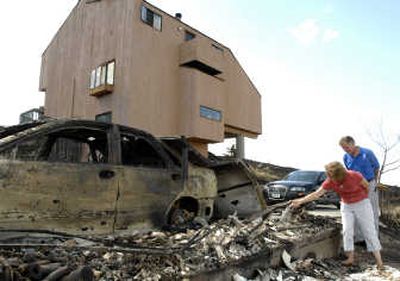Firefighter crews start burnouts near Ketchum

Firefighters began burnout operations Tuesday west of Ketchum, Idaho, in a move designed to starve the Castle Rock wildfire of fuel if it continues to bear down on spendy vacation homes in the mountains near the Sun Valley resort town’s boundaries.
At the same time, fire managers began focusing their attention on a spot fire that sparked Monday night on the Castle Rock’s southeastern flank, about four miles from a collection of homes.
That fire’s rapid growth through stands of dead timber and dry brush prompted fire managers to call in air tankers to dump fire retardant all day Tuesday and to issue a voluntary evacuation order for residents in the area.
“The new fire is one we would rather not have to deal with,” said fire manager Dave Olson. “We want people in that area to be aware of the potential danger, take time to move property, livestock or recreational vehicles. Gather up those things and move them in a safe location.”
Elsewhere across Idaho, light rain and cooler temperatures kept some fire growth in check.
Rain gave firefighters a break on the newly combined Cascade complex of fires in the Boise National Forest.
Fire coordinators also decided to send roughly 10 fire crews – made up of 20 people each – home or reassign them to other fires, Mazzier said. The shift is part of a change in strategy for two major fires – the Cascade complex, burning on nearly 250 square miles about 25 miles southeast of McCall, and the Landmark complex, spread across 75 square miles about seven miles south of the tiny mountain town of Yellow Pine.
Fire managers say they expect those two groups of fires to join at some point and even fire crews’ best efforts aren’t likely to stop the flames from spreading.
Even with the reduction in force, between 600 and 1,000 firefighters will remain to protect structures and more will be called if needed, Mazzier said.
The favorable weather may offer only a temporary respite. Warmer, drier weather is expected over the next few days with the wind kicking up again over the weekend, he said.
The 317-square-mile East Zone complex of fires also eased slightly in the damp weather, fire managers said. That blaze, burning on national forest land east of Donnelly, was about 10 percent contained. Firefighters working the complex were assessing buildings in the tiny community of Burgdorf Junction to see what protective measures would be needed in case the fire – burning about four miles to the east – moves closer.
So far in Sun Valley, most residents have fled from the 100 summer cottages and high-priced homes deemed at most immediate risk from the 17-square-mile Castle Rock fire. Olson said the fire crept closer Tuesday, but grew slowly.
Crews began burnout operations along a line about 1 1/2 miles west of city limits and the Big Wood River. The plan for the next several days is to extend the burnout west another four miles along the Warm Springs Road through a canyon.
“The concern is with the way the fire is positioned right now,” Olson said. “With the right pattern of wind there is the potential for it to move down into the canyon of Warm Springs Road … and that could be trouble.”
More than 560 firefighters are assigned to the Castle Rock fire.
Montana
Residents returned Tuesday to a 300-home rural subdivision where a wildfire had destroyed two homes, as authorities said the 800-acre blaze was under control.
“There’s just smoke in a few places but the fire is out,” said Jim Kraft, emergency services director for Yellowstone County.
Separately, most residents from 120 homes evacuated because of the Black Cat fire northwest of Missoula were expected to be allowed to return beginning at 8 p.m. Tuesday. Fire officials said a quarter-inch of rain that fell overnight Monday allowed them to rein in the 18-square-mile fire.
Mop-up efforts were expected to continue for the next couple of days in the Emerald Hills subdivision east of Lockwood, where two homes and church cabin were destroyed by the fast-moving Ford fire Sunday night and early Monday morning.
Several outbuildings and vehicles also were lost, but authorities said crews saved about 50 homes that otherwise would have burned.
The fire ripped through Emerald Hills almost exactly a year after a larger 2006 fire burned through the subdivision, destroying one home. Near the town of Seeley Lake, the Jocko Lakes fire was estimated at 34,810 acres, or 54 square miles, and was 28 percent contained. One home has been destroyed in that fire, and several others damaged.
The Placid Lake area remained evacuated, but residents might be allowed to return Wednesday if progress on the blaze continued as expected, officials said.
Authorities lifted evacuation orders Tuesday for more than 200 cabins near an 84-square-mile group of fires burning in three national forests. The fires are part of the Sawmill complex, which has burned 54,100 acres, and was 10 percent contained.